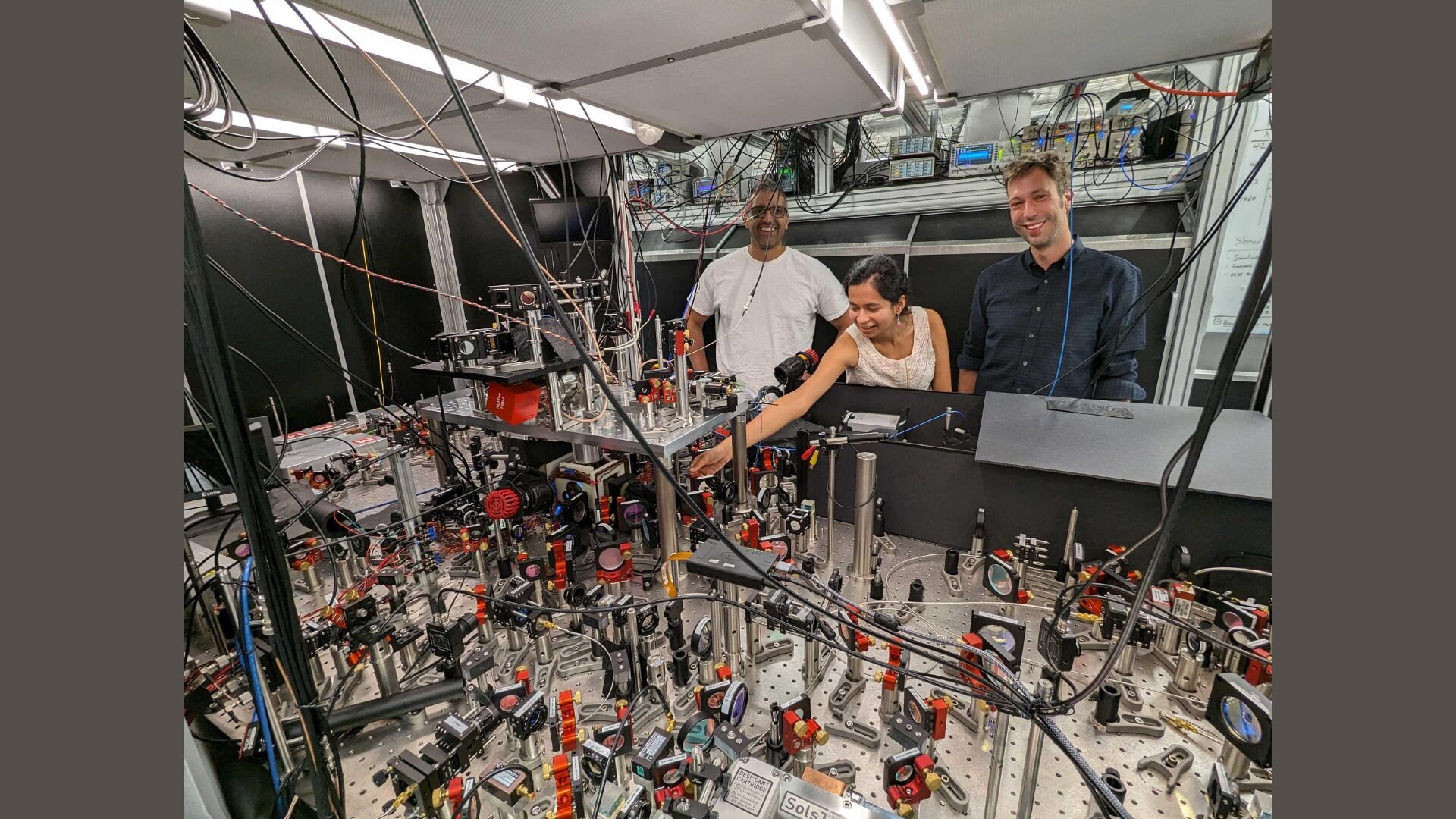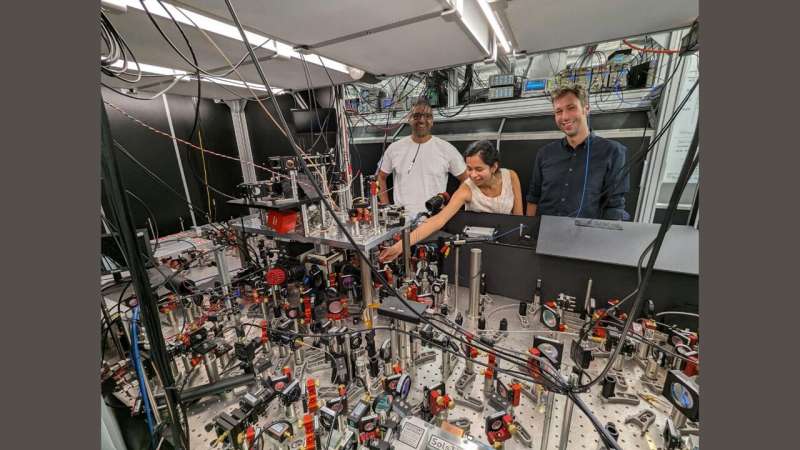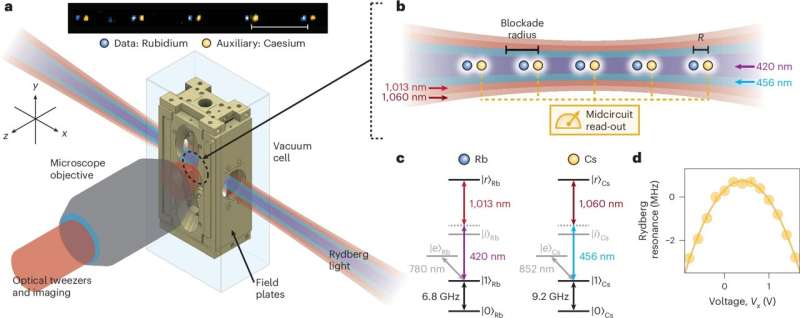

A study in Nature Physics has realized a dual-species Rydberg array combining rubidium (Rb) and cesium (Cs) atoms to enhance quantum computing and its applications.
The use of neutral atoms as quantum bits or qubits is not new to the quantum world. Neutral atoms are trapped using optical tweezers, which are focused laser beams, to manipulate the atoms to store and perform computations.
Neutral atoms are used for analog quantum simulations and digital quantum computations. They are a promising avenue for fundamental research as well as quantum computing applications due to their scalability (up to thousands of qubits), their long coherence times (beyond seconds), and the availability of high-fidelity quantum operations.
However, using a single species of neutral atom for quantum applications presents challenges, such as the implementation of mid-circuit readout (measurements that are performed on a subset of auxiliary qubits in the middle of a quantum circuit) and crosstalk between auxiliary and data qubits, causing decoherence.
The research team led by Dr. Hannes Bernien from the University of Chicago circumvented this problem by using two different species of neutral atoms.
Phys.org spoke to Dr. Bernien, inquiring about his interest in exploring this particular research field. He said, “I am fascinated by the role of measurements in quantum mechanics. Of course, measurements can be used to gather information about the quantum system, but they can also be used to prepare and manipulate the system.”
The atoms used in these types of systems are called Rydberg atoms and have a unique property.
Rydberg atoms
Rydberg atoms, like the kind used in the study, are atoms in which electrons are excited to a highly excited state. This means that they are far away from the nucleus.
These atoms are huge in size, because of the large distance between the electrons and the nucleus. They also exhibit very large dipole-dipole interactions among each other, with the electron as the negative end and the nucleus as the positive.
The high excited states also allow for large coherence times, a strong requirement for qubits. Additionally, they interact well with other Rydberg atoms and can be easily manipulated using laser fields.
In the context of the Nature Physics study, the researchers used Rb and Cs Rydberg atoms to create their array of neutral atoms. The choice of using two different species of atoms stems from the limitations that single-species systems show.

A dual-species Rydberg array
To achieve their dual-species system, the researchers used optical tweezers to trap the Rb and Cs atoms individually. The two atomic species can be manipulated individually and without crosstalk due to their large frequency separation. Still, when excited to particular Rydberg states, certain energy levels between the atoms can be brought into resonance.
In simple terms, each atom species was tuned such that the energy levels of both species were similar. The researchers chose to do this because they discovered a previously unobserved interspecies resonance between Rb and Cs energy states, called Förster resonance.
Using their dual-species Rydberg array, the researchers implemented independent control schemes for each species, allowing for more precise control. They also developed various techniques to exploit the unique properties of the setup.
Förster resonance, blockade effects, and entanglement
The interspecies resonance increases the interaction strength and is useful for many reasons. Stronger interspecies interaction means stronger dipole-dipole interactions, enhancing their ability to interact and entangle, which allows for efficient transfer of energy (or information) between the two species.
Another advantage is linked to enhancing quantum entanglement, a cornerstone of quantum computing. The resonance can lead to strong blockade effects, where the excitation of one atom prevents the excitation of another nearby atom or even multiple nearby atoms.
The Förster resonance leads to a stronger blockade and, therefore, more efficient quantum entanglement between qubits.
Dr. Bernien further explained, “Using so-called Foerster resonances, we can achieve a regime in which the Rb-Cs interaction is much stronger than the Rb-Rb and Cs-Cs interactions. These asymmetric interactions could prove very useful for quantum information processing and open new directions for quantum simulation.”
“Furthermore, we have then used the interactions to perform a two-qubit gate between Rb and Cs as well as quantum non-demolition measurements which have motivated this research.”
By using the interspecies interactions, the researchers were able to generate a Bell state between Rb and Cs qubits. This maximally entangled state demonstrates a high degree of quantum correlation that is essential for quantum information processing tasks like teleportation and superdense coding.
The quantum non-demolition measurements mentioned by Dr. Bernien are crucial for improving the accuracy of quantum information processes, especially quantum error correction, enabling repeated measurements without losing coherence on the data qubits.
A new paradigm for quantum computing
Although the experiment was a success in demonstrating a new paradigm for qubit operations, it was not without its challenges.
Dr. Bernien said, “As in most atom array experiments, the biggest headaches are lasers. For these Rydberg excitations, the lasers must be very narrow and locked precisely. Furthermore, the electron transitions are not at the most convenient wavelengths, so there is a lack of reliable laser technology.”
Despite these challenges, the realization of a dual-species Rydberg array is particularly enticing for quantum error correction (QEC). QEC is a method used to detect and correct errors in quantum computations without disturbing the quantum information.
This method can be efficiently used to extract errors from data. Dr. Bernien touched upon this application and those for quantum simulations.
“I anticipate that multiple rounds of error correction will be possible along with feed-forward operations to fix the errors if desired. For quantum simulation, I am very intrigued by the possibilities that the new interaction regimes open up. We are already collaborating to explore the phase diagram in these regimes and study non-ergodic dynamics in dual-species arrays,” he said.
The research team is also looking forward to exploring the application of such systems for quantum-many-body physics, measurement-induced phase transitions, and measurement-altered dynamics.
More information:
Shraddha Anand et al, A dual-species Rydberg array, Nature Physics (2024). DOI: 10.1038/s41567-024-02638-2.
© 2024 Science X Network
Citation:
Dual-species atomic arrays show promise for quantum error correction (2024, October 15)
retrieved 15 October 2024
from https://phys.org/news/2024-10-dual-species-atomic-arrays-quantum.html
This document is subject to copyright. Apart from any fair dealing for the purpose of private study or research, no
part may be reproduced without the written permission. The content is provided for information purposes only.